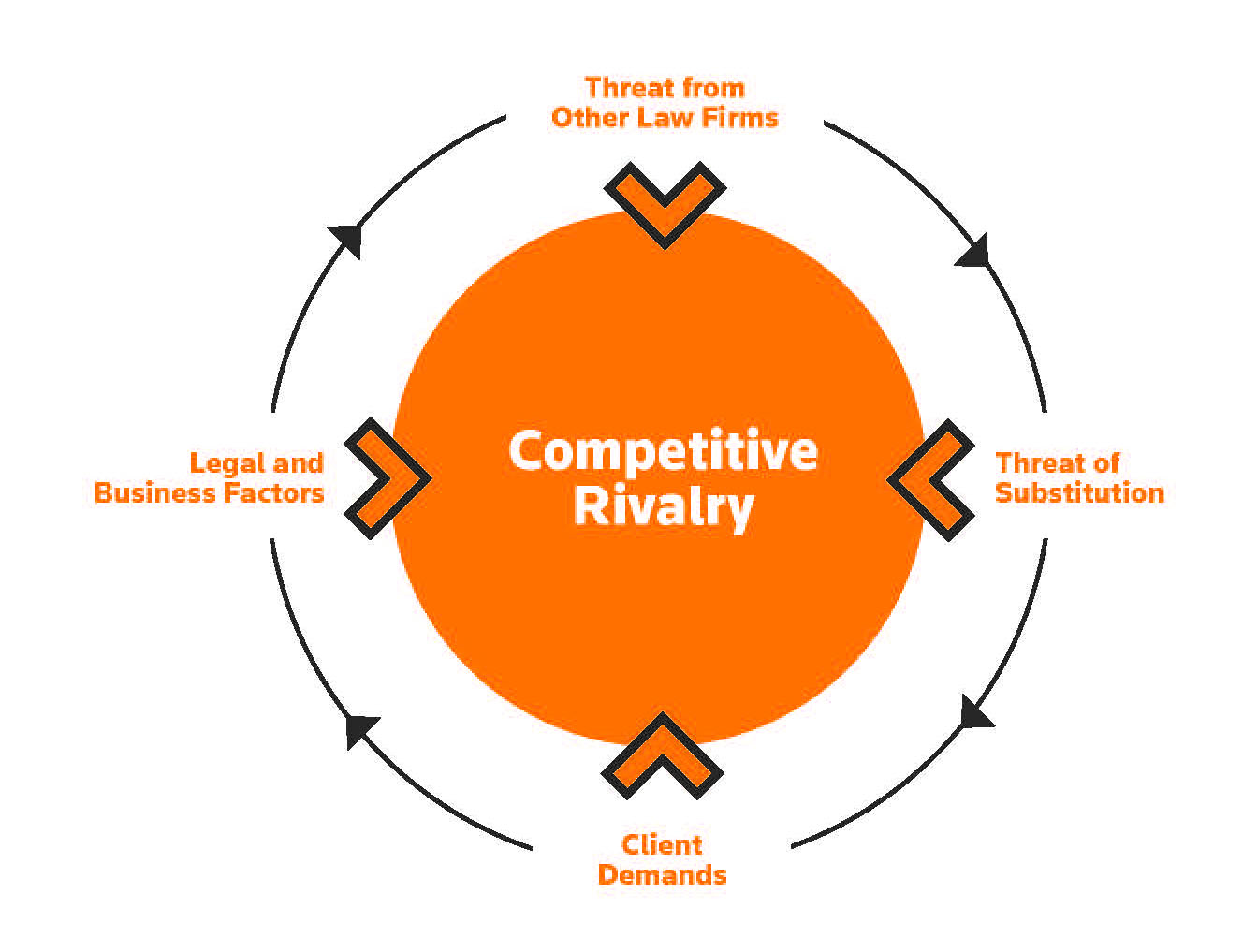The first two blogs in this series looked at the market conditions facing firms wanting to compete in the post-COVID environment. They covered the need for a competitive strategy as well as how clients are going about securing legal services. Armed with that understanding, the next step is to build your strategy.
Crafting a truly differentiated competitive strategy requires an objective evaluation of your law firm and the markets where you compete. This is not a task isolated to the marketing and business development teams. Competitive strategy also affects the way lawyers are compensated and incentivized to meet new firm goals. In fact, the impact of a new, or more focused, competitive plan will be felt across the firm.

Harvard business professor Michael Porter offers what is widely considered the best model for analyzing a competitive environment. The Five Forces asks the user to consider five key elements in their competitive environment. While this model can be applied in any industry, its relevance for law firms is undeniable. Let’s examine each force in a little more detail:
1. Threat of other lawyers and law firms: How difficult is it for a new lawyer or law firm to enter your market? How strong are your existing competitors? How likely are your current or potential clients to consider them?
It’s unlikely this force is weak in your market since the legal industry at all levels is facing increasing competition, but a high degree of strength among your opponents will have a significant impact on your strategic planning. If you enjoy a position of power due to your particular practice area, reputation, or client loyalty, you can spend more time addressing the other forces. If you find yourself facing a very high threat from other lawyers and law firms, you may need to do some additional investigation into their competitive advantages. While it’s unlikely that a new law firm will open during this tumultuous time, many existing firms are shifting to new practice areas that may see them encroaching on your territory.
2. Threat of substitution: Where else can your clients go for some or all of the services you provide?
Given their changing legal needs and the need to get the best value in every aspect of their operations in this new environment, some clients may be more likely to switch to another provider that can offer the best outcome for the most reasonable fee. From online legal service providers to alternative legal solutions providers (ALSPs) and the Big Four, legal clients of nearly every stripe have non-lawyer options for their matters. This force encourages lawyers and firms to consider what is truly unique about their practice. Put simply, there will always be a viable alternative for many of the matters your clients bring you. For legal professionals in markets with a high threat of substitution, the path forward likely involves letting go of some of the work the substitutes are taking and refocusing your efforts on the services only you can perform for your clients.
3. Client demands: How are your clients’ demands changing? Are you struggling to meet any of them? How much do their demands affect your pricing strategies, investments, and profitability?
Everyone in the legal profession is working to meet and exceed client demands, especially considering the new post-COVID environment. But it’s important to take stock of this pursuit’s effect on your business. For instance, you may need to make technology investments to meet your clients’ demands. Even so, if they are unwilling or unable to pay the prices you require to make those investments, you’ll need to do some additional strategizing.
4. Legal and business factors: How do changes in the law affect your practice? What impacts do changes in the economy, technology, and the legal workforce exert?
Every lawyer is accustomed to the evolution of the law. Keeping pace with these changes is table stakes for the profession, yet some practice areas change more frequently or dramatically than others and require constant scrutiny. This can be particularly important during times where an extremely fluid legal environment could see some unprecedented court decisions. It’s also important to consider the impact of the “business” forces on your practice alongside the legal ones. As the effects of the Great Recession linger, cost pressures may make it difficult to grow profits. Millennial and Gen Z lawyers bring new perspectives to and expectations for the profession. And as the pace of technology change accelerates, it is critical to have a technology roadmap in place.
5. Competitive rivalry: This force can be treated as the sum of the other four forces you’ve evaluated. Unless you’ve already done so, consider the number of direct and indirect competitors to your firm and the qualitative or quantitative differences between them.
While competitive rivalry is undoubtedly a separate force, the most useful application for the legal profession is as a single point of reference for the model as a whole. High rivalry is typically an indicator that many of the other forces are strong, while low rivalry likely indicates weakness in the other forces. Depending on your goals, this force can work as a starting or ending point for your analysis. In the current market, however, the increase in general competition for business will almost certainly keep competitive rivalry on the high side.
From analysis to action
While it’s impossible to predict the outcome of any individual firm’s analysis, it is vital to ensure the results translate into action. This may mean new business development strategies, reprioritizing practice area focus, new hiring guidelines, or new technology investments. Competitors are working every day to gain market share and establish dominance. Savvy firm leaders can use this framework as a practical tool to make impactful decisions for their firms.
Now is the time to learn more about the solutions that can help your firm differentiate itself from the competition. Stay tuned for the final installment of this series, where we’ll discuss laying a solid foundation from which to launch your firm’s competitive strategy.









